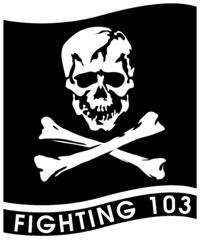VFA-103
| Strike Fighter Squadron 103 | |
|---|---|

VFA-103 Insignia
|
|
| Active | 1 May 1952 – present |
| Country | United States of America |
| Branch | |
| Type | Fighter/Attack |
| Role |
Close air support Air interdiction Aerial reconnaissance |
| Part of | Carrier Air Wing Seven |
| Garrison/HQ | NAS Oceana |
| Nickname(s) | Jolly Rogers |
| Colors | Gold, White, and Black |
| Mascot(s) | Ensign Jack "Bones" Ernie |
| Engagements |
Operation Desert Shield Operation Desert Storm Operation Southern Watch Operation Enduring Freedom Operation Iraqi Freedom Operation Inherent Resolve |
| Decorations | Safety "S" Mutha Fighter Spirit Award 2005, 2007, 2011, 2013 Battle Efficiency "E", 2006, 2007 Rear Adm C. Wade McClusky Award 2007 Golden Wrench Maintenance Award 2006 Golden Anchor Retention Award 2006 |
| Commanders | |
| Current commander |
Commander Scott "Bobby" Buchar |
| Aircraft flown | |
| Fighter |
FG-1D Corsair F9F-6 Cougar F-8 Crusader F-4 Phantom II F-14 Tomcat F/A-18F Super Hornet |
Strike Fighter Squadron 103 (VFA-103), nicknamed the Jolly Rogers is an aviation unit of the United States Navy established in 1952. VFA-103 flies the F/A-18F Super Hornet and is based at Naval Air Station Oceana, Virginia (US). The squadron's radio callsign is Victory and it is assigned to Carrier Air Wing Seven.
The original VF-103 squadron insignia was a cloverleaf, and the aircraft tailfins had a horizontal yellow arrow outlined in black. Later a stylized aircraft darting through the leaf was added, along with a baseball bat. The baseball stemmed from an early skipper who often carried one with him. In 1991, VF-103's aircraft used the squadron insignia for tail-art, in place of the bold arrow. When the Sluggers became the Jolly Rogers following the disestablishment of VF-84 (1955-95), they adopted the famous white skull-and-crossbones.
The Jolly Rogers have always displayed some of the most recognizable squadron markings in the world: sinister white skull-and-crossbones on all-black tails, with gold bands wrapped around the tip of the tail fins, and black bands with gold chevrons (known as vagabonds strips from the Crusader days of VF-84) run down the sides of the forward fuselage.
Four distinct U.S. Naval Aviation squadrons have used the name and insignia of the Jolly Roger: VF-17, VF-61, VF-84, and VF-103, since redesignated as VFA-103. While these are distinctly different squadrons that have no lineal linkage, they all share the same Jolly Roger name, the skull and crossbones insignia and traditions. After disestablishment of VF-84 in 1995, the Jolly Rogers name and insignia were adopted by VF-103, which later became VFA-103, the subject of this article. There has been only one squadron designated VF-103.
VF-103 (the "Sluggers") was activated on 1 May 1952 and equipped with the FG-1D Corsair. The squadron was assigned to Carrier Air Group 10 (CVG-10) and made a short cruise aboard USS Lake Champlain in late 1952. Thereafter, VF-103 transitioned to the F9F-6 Cougar and adopted the nickname "Flying Cougars". CVG-10 went aboard USS Randolph for her shakedown cruise following her reactivation to the Caribbean between August and November 1953. The air group was then reassigned to the USS Coral Sea and VF-103 was equipped with the F9F-8B. The carrier was deployed to the Mediterranean Sea between August 1956 and February 1957. This was the last time that VF-103 operated from a straight-deck carrier.
...
Wikipedia
